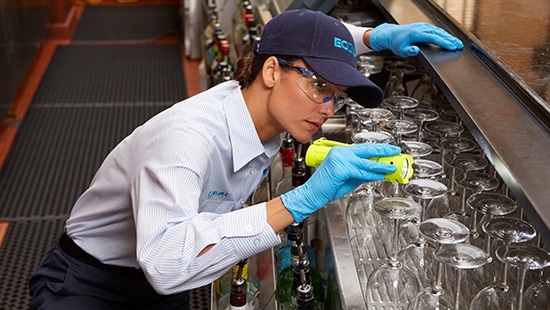Chicago Crawler Extermination Services: Safe and Reliable Removal
Chicago Crawler Extermination Services: Safe and Reliable Removal
Blog Article
A Comprehensive Guide to the Various Kinds Of Insect Control Methods
Bug control is an important facet of keeping a healthy and balanced and habitable atmosphere, whether it's in our homes, gardens, or workplaces. With the myriad of parasite control approaches offered, it can be overwhelming to discover one of the most efficient service for a specific bug trouble. From chemical and biological techniques to physical and natural choices, each technique has its own unique strengths and constraints. In this detailed overview, we will certainly check out these different kinds of pest control techniques, supplying insights into their applications and benefits. By the end, you will have a clearer understanding of which approach may be the best suitable for your insect control requirements. So, let's dive right into the interesting world of bug control and reveal the tricks to a pest-free environment.
Chemical Parasite Control Methods

One common kind of chemical pest control is pesticides. Pesticides are chemical substances that are especially created to eliminate or repel insects. They can be used in different types, such as sprays, baits, or cleans. Pesticides target certain bugs, such as mosquitoes, termites, or ants, and can be made use of both inside and outdoors.
Another sort of chemical pest control is rodenticides. These are chemical substances developed to regulate populations of rats, such as rats and computer mice. Rodenticides are generally used in bait form, which attracts the rats and after that eliminates them after intake. They are frequently used in agricultural settings, in addition to in domestic and industrial structures (Customized pest control solutions Chicago).
Weed killers, likewise referred to as herbicides, are one more kind of chemical bug control technique. Herbicides are designed to selectively kill undesirable plants, known as weeds, without causing injury to preferable plants. They are typically used in farming, landscape design, and horticulture to manage the growth of unwanted greenery.
While chemical bug control methods can be highly effective in eliminating parasites, it is essential to use them sensibly and comply with safety and security standards. Overuse or misuse of chemical pesticides can have adverse effect on human wellness and the atmosphere. It is important to employ these approaches responsibly and take into consideration different pest control strategies whenever possible.
Biological Bug Control Methods
Organic parasite control techniques involve using living microorganisms or all-natural substances to take care of and manage pest populaces. Unlike chemical techniques, which often rely on artificial chemicals, organic control approaches make use of the natural adversaries of pests to control their populations. This approach is taken into consideration even more eco pleasant and lasting, as it lowers using damaging chemicals and reduces the risk of chemical resistance.
One commonly used organic parasite control approach is the introduction of all-natural killers or parasites. Ladybugs are introduced to manage aphids, while specific wasp varieties are released to target caterpillars. These predators and parasites feed on insects, lowering their numbers and preventing infestations.
Another biological control technique is the usage of microorganisms. Certain microorganisms, viruses, and fungis can be employed to contaminate and kill details insects. The microorganism Bacillus thuringiensis is typically used to manage caterpillars, as it creates contaminants that are lethal to these pests.
Organic control techniques can also entail the use of pheromones or natural materials that interrupt the breeding patterns of insects. By conflicting with their reproduction, these techniques assist to lower pest populaces over time.
While organic parasite control approaches are normally efficient, they might need longer periods to attain wanted outcomes contrasted to chemical techniques. In addition, mindful factor to consider needs to be provided to the selection and release of natural opponents to avoid unintentional harm to beneficial organisms or ecological communities.
Physical Parasite Control Techniques
To properly manage and control pest populaces, alternate bug control methods called physical parasite control techniques are utilized. These approaches entail using physical barriers, catches, or gadgets to avoid pests from accessing or harming building. One usual physical pest control technique is using displays or internet to maintain pests out of structures or yards. These displays are generally constructed from great mesh product that enables air flow while stopping insects from entering. Another physical parasite control technique is the installment of fencings or walls to keep larger insects, such as deer or rabbits, out of gardens or agricultural fields. These obstacles literally block the parasites' access to the area, lowering the possibility for damage. In addition, traps and tools can be made use of to record or ward off bugs. Sticky catches can be put in areas where insects are a trouble, and the bugs become stuck to the glue surface area. Ultrasonic gadgets can also be used to emit high-frequency noises that are unpleasant to pests, triggering them to leave the location. Physical insect control approaches are an eco-friendly choice to chemical pesticides, as they do not rely upon the use of dangerous chemicals.
Natural Bug Control Methods
Natural insect control methods use a sustainable and eco-friendly approach to managing and eliminating parasites. One of the most common natural parasite control techniques is biological control. By embracing these natural pest control methods, individuals and neighborhoods can properly manage bugs while reducing the unfavorable you can find out more impacts on the setting and human health.
Integrated Bug Management (IPM)
Integrated Parasite Administration (IPM) is an extensive and organized strategy get redirected here to pest control that combines various methods and methods to successfully manage pests while minimizing making use of chemical pesticides. IPM aims to keep pest populaces below the economic injury degree by using a combination of social, organic, and chemical control approaches.
Social control techniques include modifying the environment to make it less desirable for pests. This can consist of practices such as plant rotation, proper hygiene, and making use of resistant plant selections. By producing unfavorable conditions for insects, cultural control methods can substantially decrease pest populations.

Chemical control methods are used as a last option in IPM. They entail the targeted and wise usage of chemicals to take care of parasite populations. Unlike traditional pest control techniques, IPM aims to reduce the usage of chemical pesticides by using alternate methods.
Integrated Parasite Administration (IPM) is a proactive approach that focuses on lasting bug management instead than relying solely on reactive procedures. By Home Page integrating several control methods, IPM offers a more sustainable and eco pleasant approach to pest control.
Conclusion
It talked about chemical, biological, physical, and all-natural bug control methods, as well as the integrated pest management method. By recognizing these numerous approaches, people can make educated choices on which insect control method is most suitable for their specific needs and choices.
Report this page